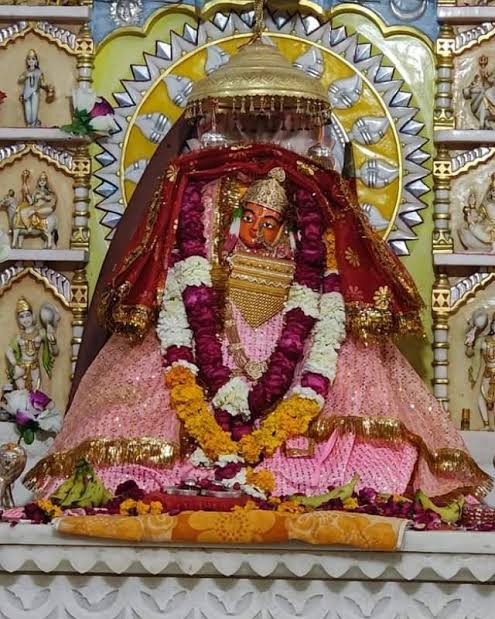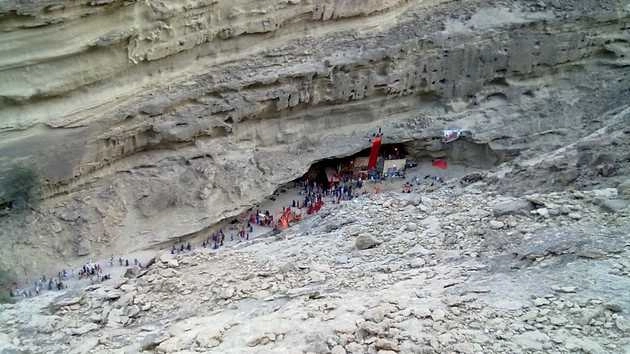Story of Vankal Viratra Mata, History and Information of the Temple

History of Viratratra Dham
On remembering the name of Viratra Dham, the curiosity to visit Vankal Viratra Mata arises in the mind, after just seeing the miraculous goddess Vankal Viratra Mata of Viratra Dham, one feels happiness, peace and joy. This famous pilgrimage site is situated in the midst of black brown mountains and huge sand dunes amidst the natural picturesque views of the desert in the boundary of Dhok village of Chohtan tehsil of Barmer district bordering western Rajasthan.
The story of Vankal Mata and King Vikramaditya
Regarding the origin of Vankal Mata, the main miraculous goddess of Viratra Dham, it is said that Viratri, the adopted daughter of Lord Brahma, the creator of the universe, is not only addressed as Vakrayi Maa , Maa Vakrangi , Maa Vankal , Maa Vankul , Viratra Maa , Vankal Devi , but Mataji's temples and worshipful religious places are also built in different parts of the country. According to mythological stories, it is said that the ruler of Ujjain, Veer Vikramaditya, ended the atrocities of the Shakas in the year 375 and won the war against them. In the joy of this victory, he went on a pilgrimage to Hinglaj Devi.
There, the goddess was very pleased with the engrossed meditation and worship of the goddess. The Goddess was impressed by the respect, wisdom and humility of King Vikramaditya and blessed him and said, "Your name will be known in history for centuries as a just ruler. King Vikramaditya was pleased with the blessings of the Goddess and expressed his wish to come with her to Ujjain for daily darshan of the Mother. Mother Hinglaj said, "I cannot leave this Shaktipeeth and go anywhere else, but impressed by your devotion, I will accompany you in the form of Shakti, who will incarnate in the name of Vankal in the future. But while taking me in the form of Shakti, do not look back, if you do so, I will not be able to accompany you to Ujjain."
This is the form of Maa Hinglaj Temple:
The temple of Maa Hinglaj is situated in a cave. The idol of the mother is seated in a cave built on a high hill. There is a temple of Mata Hinglaj Devi in the mountain cave which has no door. The pilgrims who go around the temple enter the cave from one side and exit from the other side. Along with the temple is the place of Guru Gorakhnath. It is believed that Mata Hinglaj Devi comes here to take bath in the morning.

Here Mata Sati is worshipped in the form of Kottari and Lord Bholenath in the form of Bhimlochan Bhairava. In the Mata Hinglaj temple complex, apart from the idols of Shri Ganesh and Kalika Mata, there are famous pilgrimage places like Brahmakund and Tirkund. This Adi Shakti is worshipped not only by Hindus but Muslims too give her a lot of respect. One has to climb the stone stairs to enter the Hinglaj temple. The first darshan in the temple is of Shri Ganesh who gives Siddhi. In the front is the idol of Mata Hinglaj Devi who is the incarnation of Mata Vaishno Devi.
Interesting story of mother Viratra coming from Hinglaj to Viratra Chohtan
Veer Vikramaditya took the Shakti idol given by the Goddess from Hinglaj Shaktipeeth and left for Ujjain with military honours. On the way, a huge crowd gathered to see the Shakti idol. The royal convoy of King Veer Vikramaditya stopped for rest on a huge sandy dune like hill between Bijrad and Ghoniya near Chohtan tehsil of present Barmer district. Departing from here, the royal convoy considered Viratara hill i.e. Bhura Bhakhar Hiran Dungar, west of present Dhok village, as a strategically safe place and rested there for the night and placed the Shakti idol brought with them temporarily in a cave here for worship. It is now famous as an important and historical religious place of Viratara Teerth by the name of Aadupura.
Story of Maa Vankal Temple of Chohtan
In the morning, when Veer Vikramaditya started moving ahead from Chauhatan with his army and Shakti idol, he lost his senses and by mistake he turned back and looked towards Hinglaj. On this, there was a voice from the sky and Hinglaj Devi Maa said- O King, you have turned towards Hinglaj. This has fulfilled my promise and now I cannot go further. I will stay here on the peak of Bhura Bhakhar and destroy the demons who create havoc here. When Veer Vikramaditya heard these words from the mouth of Shakti Mata Shri Hinglaj, he was left speechless, disappointed and as per the promise of the Goddess, he installed the Shakti idol brought by him at a height of about 1100 feet from the ground level with devotion and a grand religious festival. Since then, this Bhura Bhakhar is called Hiran Bhakhar because the colour of its stones is like that of a deer. But it became famous as Viratara due to the night halt of Veer Vikramaditya, which has today become a grand religious place for the devotees in the form of Viratara Dham.
Construction of Veeratara Vankal Mata Temple
After Veer Vikramaditya established the Shakti idol on Bhura Bhakhar Hiran Dungar of Veeratra, this place became popular by the name of Viratra. King Veer Vikramaditya initially established the idol of Shakti Mata/ Viratra Mata on a small platform, which was later converted into a temple by devotees by putting an iron roof on it. When any devotee comes to visit Viratra Dham, he definitely visits Bhura Bhakhar Hiran Dungar, which is currently known as Garh Mandir. After many people benefited from the miracles of Garh Mataji, the faith, belief and devotion of the devotees started increasing. Along with Garh Mata Mandir of Veeratra, an increasing number of pilgrims continued to visit the Talhati Mata Mandir. Seeing the increasing glory of this pilgrimage Dham, the trust board here decided to build a new temple in place of the ancient temple of Garh Mata located on Hiran Bhakhar. The ancient temple was erected on Wednesday, 26 June 1967, Ashadh Vadi 5, Vikram Samvat 2054, and the foundation stone of the temple was laid on Sunday, 6 July 1997, in the holy constellation, and the construction of the entire temple was started with marble stones.
Viratara Mata temple at the foot of the mountain
The most popular and miraculous temple of Viratara Tirtha is the Taleti (foothills) temple of Viratara Mataji. This temple is built like an island between hills and sand dunes at the ground level. Regarding the construction of this temple, it is said that the pilgrims visiting Viratara's Garh temple had to face great difficulty in climbing the difficult one kilometer of a hill of about 1100 feet. The pilgrims visiting for the darshan were scared of the difficult climb of the hill, the rough and rocky path, the inaccessible hill and the fear of wild animals. It was rare for an old and helpless person to visit Garh Mataji. In such a situation, an old and extremely devoted devotee of Mataji of Maganiyar caste, standing on the foothills, told her inability and made a compassionate request to Mataji to come down. Mataji was pleased with the prayer of her devoted female devotee. Meanwhile, a small or a big stone from the top of the mountain fell down on the ground and broke into two pieces, from which the idol of Mataji appeared, which is worshipped today as the original idol of the temple at the foot of Viratara Mataji. Another legend is popular in this regard that a goldsmith woman did not have a son, so she prayed to Mataji with devotion and prayed to her for a son, by the grace of the mother she got a son and she started going to the Garh Mataji temple to offer Prasad, she had a cloth covered plate of Prasad in her hand. A crow flew over the cloth plate and tasted the Prasad kept in it, which the goldsmith woman saw, then she started climbing the difficult hill to offer the fake Prasad. Her foot slipped and she fell into a deep pit hitting the mountain rocks. She started screaming after being badly injured by the mountain rocks. Then a Maganiyar was standing below and praying to Mataji in his singing. He heard the woman's painful voice and went to her and saw that the seriously injured woman had died. Seeing this scene, Maganiyar made a compassionate request to Veeratra Mata and requested her to come down from the hill and give darshan to the devotees. Mataji accepted Maganiyar's request and a big stone rolled down from the top and fell on the ground and broke into two pieces, from which the idol of Viratra Mataji appeared.
Present Viratara Mata Temple
For the reconstruction of the Garh Mata temple of Viratara, the material was started to be brought up with great difficulty from the ground level through the cemented stairs in about 1240. Due to the faith of the devotees, financial support of the donors, enthusiasm of the trust board, devotion of the workers, a small shikhardhari marble temple facing east was built on the top of Bhura Bhakhar Hirne Dungar. Its consecration was done amidst a grand and historic religious ceremony on Vikram Samvat 2056 Magh Sudi Purnima, Sunday, corresponding to 31 January 1999. In the newly constructed Garh temple, a 35-inch statue of Shri Viratara Vankal Mata riding a lion has been installed facing east. Apart from this original statue, the statues of Shri Kala in the northern rampart Gokh and Shri Gora Bhairav in the southern Gokh were installed to the north of the original Gambare of the temple. The statues of Shri Kuber in the north, Shri Varun in the south and Shri Yamdev in the west have been installed in the Mangal Gokhs of the temple peak. A small temple has been constructed facing east behind the newly built Garh Mata Mandir. In which the ancient idols related to the Garh Mandir have been placed for darshan. Apart from these two temples, two drinking water tanks, three rooms with verandahs, three bathrooms etc. have been constructed here for the convenience of travellers, devotees, visitors.
Vankal Viratra Dham Place
To visit Viratara Dham, one can reach Barmer from different parts of the country by rail and bus. After reaching the ancient and historical city of Chohtan 55 kms from Barmer by a paved road, Vankal Viratara Dham is situated in the lap of the hills 4 kms west of Dhok village 10 kms from there.